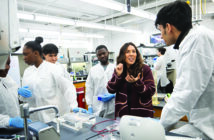Every year, at Alpert Medical School’s Match Day celebration, there are ebullient shrieks and bear hugs and happy tears. There are parents and siblings and friends lined up in endless photographic iterations. There is champagne and a band. The air is electric.
But at the celebration in March, on the balcony that rings the Medical School’s soaring lobby, a handful of fourth-year students escaped the din. “I don’t think most people understand how hard this is,” said one, leaning against a railing, letter in hand.
“They have no idea,” another replied.
The Match marks the conclusion of months of interviews and travel and worried anticipation, built on years of grueling study and sacrifice. It is the launch of a medical career. It is decisive and defining.
And recently, these pressures seem to be rising. “Many of us in the GSA [Association of American Medical Colleges’ Group on Student Affairs] definitely feel that the Match is getting more and more competitive—especially in the very competitive specialties like orthopedics, plastics, and dermatology,” Director of Student Affairs Alexandra Morang says.
This year’s Match was the largest since 1952, when it was launched by the National Resident Matching Program (NRMP). From 1980 to 2000, the number of medical school graduates was stable. But in response to the mounting physician shortage, Alpert Medical School and other schools of medicine have begun to increase enrollments. Additionally, more than a dozen schools, both allopathic and osteopathic, have been established in the last five years. US-born and foreign graduates of international medical schools have expanded the applicant pool further.
As the number of new doctors has grown over the past two decades, however, the number of federally funded residencies has increased only minimally, due to a cap that Congress imposed as part of the 1997 Balanced Budget Act. The result is an approaching mismatch between the number of graduating students and the number of available residency slots.
This year, according to the NRMP, 26,678 first-year residency positions were offered. Although heralded as a successful Match overall, the 2014 result can in part be explained by a large drop in applications from the most competitive group—US-based seniors—with 8 percent fewer allopathic students applying this year than last. One possible explanation for this decrease is that more students are staying put for more than four years to complete dual-degree programs, Mona M. Signer, executive director of the NRMP, told the medical news website MedPage Today in March.
Nonetheless it appears that several hundred US medical students did not match this year. As the Association of American Medical Colleges (AAMC) put it in a statement released after the Match, “There may be too few residency positions for all the newly graduated doctors in the nottoo- distant future.”
At Alpert Medical School, the impact has been minimal to date: 2014 saw a highly successful Match, with 99 percent of students placing, and approximately 90 percent in one of their top three choices, Morang says.
But there is evidence of growing difficulty. In the past, Morang says, students typically interviewed at seven to 10 programs. Now they’re logging twice as many interviews—and this year, top students who received early interview offers held onto them. “Previously, these same students would have dropped some of those interviews,” she says. These declined interviews would typically go to the next tier of students. “But we saw very few students in that second tier get additional interview offers after the initial wave—very few opened up.”
In 2016, entering US medical classes will be 30 percent larger than they were in 2002. To prevent a major med student-residency slot mismatch and to mitigate the growing physician shortage, Congress has reintroduced bipartisan bills to add 15,000 Medicare-funded residency positions over the next five years—legislation supported by both the AMA and AAMC. “It will help,” Morang says. But passage is not guaranteed, due to the projected $9 billion cost to close the gap.
Many are worried—and not just because they want to be among the revelers on their own Match Days. “Medical students across the nation are concerned that there won’t be enough slots to train,” Grayson Armstrong, MPH MD’15 told MedPage Today. “It’s not about getting a job. It’s about patients getting the care they need.”



